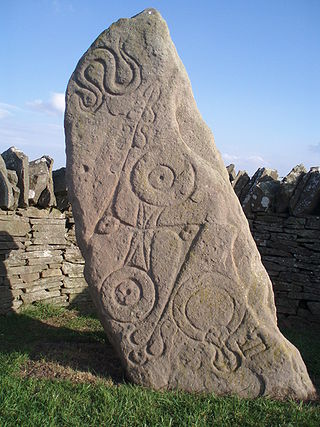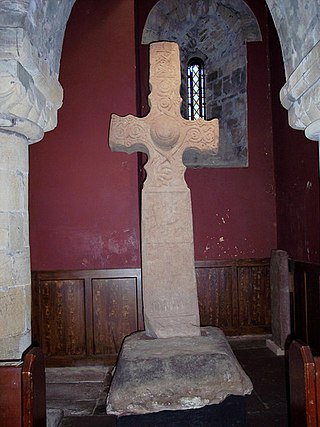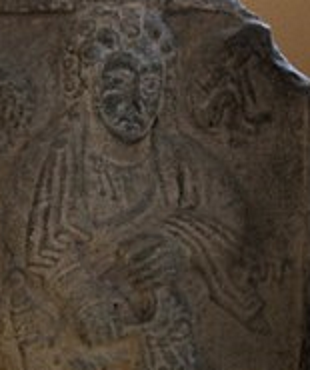Kenneth MacAlpin or Kenneth I was King of Dál Riada (841–850), and King of the Picts (843–858) of likely Gaelic origin. He inherited the throne of Dál Riada from his father Alpín mac Echdach, founder of the Alpínid dynasty. Kenneth I conquered the kingdom of the Picts in 843–850 and began a campaign to seize all of Scotland and assimilate the Picts, for which he was posthumously nicknamed An Ferbasach. He fought the Britons of the Kingdom of Strathclyde and the invading Vikings from Scandinavia. Forteviot became the capital of his kingdom and Kenneth relocated relics, including the Stone of Scone from an abandoned abbey on Iona, to his new domain.

The Picts were a group of peoples in northern Britain, north of the Firth of Forth, in the Early Middle Ages. Where they lived and details of their culture can be gleaned from early medieval texts and Pictish stones. The name Picti appears in written records as an exonym from the late third century AD. They are assumed to have been descendants of the Caledonii and other northern Iron Age tribes. Their territory is referred to as "Pictland" by modern historians. Initially made up of several chiefdoms, it came to be dominated by the Pictish kingdom of Fortriu from the seventh century. During this Verturian hegemony, Picti was adopted as an endonym. This lasted around 160 years until the Pictish kingdom merged with that of Dál Riata to form the Kingdom of Alba, ruled by the House of Alpin. The concept of "Pictish kingship" continued for a few decades until it was abandoned during the reign of Caustantín mac Áeda.
Drest was king of the Picts, in modern Scotland, from about 834 until 837. He was the son of King Caustantín and succeeded his uncle, Óengus, to the throne.
Óengus mac Fergusa was king of the Picts from 820 until 834. In Scottish historiography, he is associated with the veneration of Saint Andrew, the patron saint of Scotland, although this has not been proven.

Causantín or Constantín mac Fergusa was king of the Picts, in modern Scotland, from 789 until 820. He was until the Victorian era sometimes counted as Constantine I of Scotland; the title is now generally given to Causantín mac Cináeda. He is credited with having founded the church at Dunkeld which later received relics of St Columba from Iona.
Eochaid mac Áeda Find is a supposed King of Dál Riata found in some rare High Medieval king-lists and in older history books.
Fergus mac Echdach was king of Dál Riata from about 778 until 781.
Ainbcellach mac Ferchair was king of the Cenél Loairn of Dál Riata, and perhaps of all Dál Riata, from 697 until 698, when he was deposed and exiled to Ireland.

Óengus son of Fergus was king of the Picts from 732 until his death in 761. His reign can be reconstructed in some detail from a variety of sources. The unprecedented territorial gains he made from coast to coast, and the legacy he left, mean Óengus can be considered the first king of what would become Scotland.
Naiton son of Der-Ilei, also called Naiton son of Dargart, was king of the Picts between 706–724 and between 728–729. He succeeded his brother Bridei in 706. He is associated with significant religious reforms in Pictland. He abdicated in 724 in favour of his nephew and became a monk. In 728 and 729 he fought in a four-sided war for the Pictish throne.
Uuen son of Onuist, commonly referred to by the hypocoristic Eóganán, was king of the Picts between AD 837–839.
Conall mac Taidg was a king of the Picts from 785 until 789. Very little is recorded of Conall. He is mentioned twice by the Irish annals, the most reliable source for the history of northern Britain in the years around 800. He also appears in later king lists.
Áed mac Boanta is believed to have been a king of Dál Riata.
Domnall mac Caustantín is thought to have been king of Dál Riata in the early ninth century.
Conall mac Áedáin was a king in Scotland in the years around 800. It is thought that he was a king, or sub-king, in Dál Riata.
Donncoirce was probably king of Dál Riata until his death in 792.

Katherine S. Forsyth is a Scottish historian who specializes in the history and culture of Celtic-speaking peoples during the 1st millennium AD, in particular the Picts. She is currently a professor in Celtic and Gaelic at the University of Glasgow in Scotland. She graduated from the University of Cambridge and Harvard University.
Sally M. Foster is a Scottish archaeologist and senior lecturer at the University of Stirling. She specialises in the archaeology of Scotland, particularly the Picts and their neighbours in the early medieval period.




